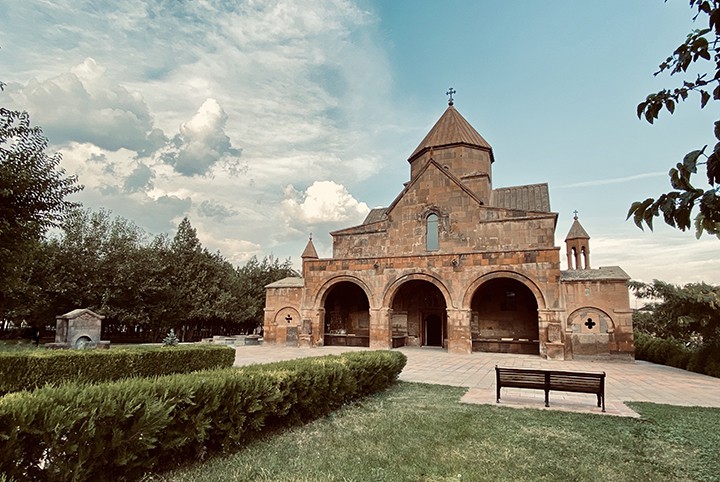ՍՈՒՐԲ ԳԱՅԱՆԵ ՎԱՆՔ

Էջմիածին քաղաքի հարավային կողմում, Սբ. Գայանեի և նրա երկու ընկերուհիների նահատակման վայրում է գտնվում Սբ. Գայանե վանքը: Այնտեղ, ըստ Ագաթանգեղոսի, 301 թվականին Գրիգոր Ա Լուսավորչի ղեկավարությամբ և նրա գցած հիմքերի վրա Տրդատ Գ Մեծը, նրա քույր Խոսրովիդուխտը և Աշխեն թագուհին վկայարան են կառուցել: 395 թվականին Սահակ Ա Պարթևը վերակառուցել է Սբ. Գայանեի վկայարանը: 630 թվականին Եզր Ա Փառաժնակերտցին քանդել է վկայարանը և տեղում սրբատաշ տուֆով շինել այսօր կանգուն Ս. Գայանե եկեղեցին, վանական միաբանություն հաստատել: Սբ. Գայանե եկեղեցին ներդաշնակ համաչափություններով, տպավորիչ ինտերիերով քառամույթ գմբեթավոր բազիլիկ է, որի Ավագ խորանի տակ գտնվում է սրբուհու` հարավ-արևելյան ավանդատնից մուտքով թաղածածկ դամբարանը:
XVII դ. եկեղեցին եղել է կիսավեր ու լքված: XVII դ. պատմիչ Առաքել Դավրիժեցին գրում է, որ Սբ. Գայանե եկեղեցու միայն պատերն ու գմբեթակիր մույթերն են կանգուն եղել: Փիլիպոս Ա Աղբակեցին 1652 թվականին հիմնովին վերակառուցել է եկեղեցին, վերականգնել նրա ծածկը և գմբեթը: Միաժամանակ Սբ. Գայանե եկեղեցու հիմքերը ստորգետնյա ջրերից պաշտպանելու համար վանքի հարավային պարսպից դեպի դաշտ ջրահեռացման համակարգ են ստեղծել, որպեսզի ջրերը նաև ոռոգման նպատակով օգտագործվեն: 1688 թվականին Եղիազար Ա Այնթապցին կառուցել է վանքի միաբանության շենքերը, պարիսպը, Սբ. Գայանե եկեղեցուն արևմտյան կողմից կցել եռակամար գավիթ սրահ, նրա հարավային և հյուսիսային ծայրերին պատարագամատույց սեղաններով Պողոս և Պետրոս առաքյալներին նվիրված մատուռներ կառուցել: Գավիթ-սրահը հետագայում ծառայել է որպես կաթողիկոսների տապանատուն: 1764 թվականին Սիմեոն Ա Երևանցին Էջմիածնի Սբ. Գայանե վանքի տարածքում կառուցել է ստորգետնյա խոշոր սառցատուն` վանքի մթերքները պահելու համար: Գևորգ Դ Կոստանդնուպոլսեցու գահակալության տարիներին (1866-1882թթ.) Էջմիածնի Սբ. Գայանե վանքի վանահայր Վահան Բաստամյանցը նորոգել է վանքը, կառուցել արևմտյան կամարակապ դարպասը, վանահոր և միաբանների բնակելի շենքերը, դպրոց, որտեղ ինքը դասավանդել է, հիմնել է տպարան և հրատարակել «Դպրոց» ամսագիրը: 1910 թվականին Նոր Նախիջևանի հայ համայնքը սև գրանիտից տապանաքար է բերել Սբ. Գայանեի գերեզմանի համար: 1959 թվականին Էջմիածնի Սբ. Գայանե վանքը նորոգվել է, եկեղեցու ներսը մաքրվել է սվաղից, հատակը սալարկվել, տարածքը բարեկարգվել, բակում կառուցվել է մատաղատուն, աղբյուր (ճարտ.` Ռ. Իսրայելյան): 1960 թվականին վանքի տարածքում Մայր աթոռի` 1920 թվականից հետո թաղված միաբանների գերեզմանների վրա դրվել են մարմարե սալիկներով տապանաքարեր: 1976 թվականին Սբ. Գայանե եկեղեցու շուրջը դարերի ընթացքում կուտակված լիցքը հեռացվել է, պատերի մեջ շաղախ է ներարկվել, և քայքայված քարերը փոխարինվել են նորերով: 1977-1980թթ. լոնդոնահայ Հարություն Մութաֆյանի բարերարությամբ, վանքի միաբանության շենքերը նորոգվել են և օժտվել ժամանակակից հարմարություններով, քարե սալերով ծածկվել եկեղեցու տանիքը և գմբեթը: Էջմիածնի Սբ. Գայանե վանքի գավթում են ամփոփված Եղիազար Ա Այնթապցի, Աբրահամ Բ Խոշաբեցի, Ղազար Ա Ջահկեցի, Մինաս Ա Ակներցի, Հակոբ Ե Շամախեցի, Սիմեոն Ա Երևանցի, Ղուկաս Ա Կարնեցի, Դավիթ Ե Էնեգեթցի, Մատթեոս Ա Կոստանդնուպոլսեցի կաթողիկոսները, իսկ վանքի շուրջը` բազմաթիվ արքեպիսկոպոսներ, եպիսկոպոսներ, վանահայրեր, Մայր Աթոռի բարերարներ, իշխաններ և նշանավոր այլ անձինք:
Սբ. Գայանե եկեղեցին 2000 թվականից գրանցված է ՅՈՒՆԵՍԿՕ-ի համաշխարհային ժառանգության ցանկում: